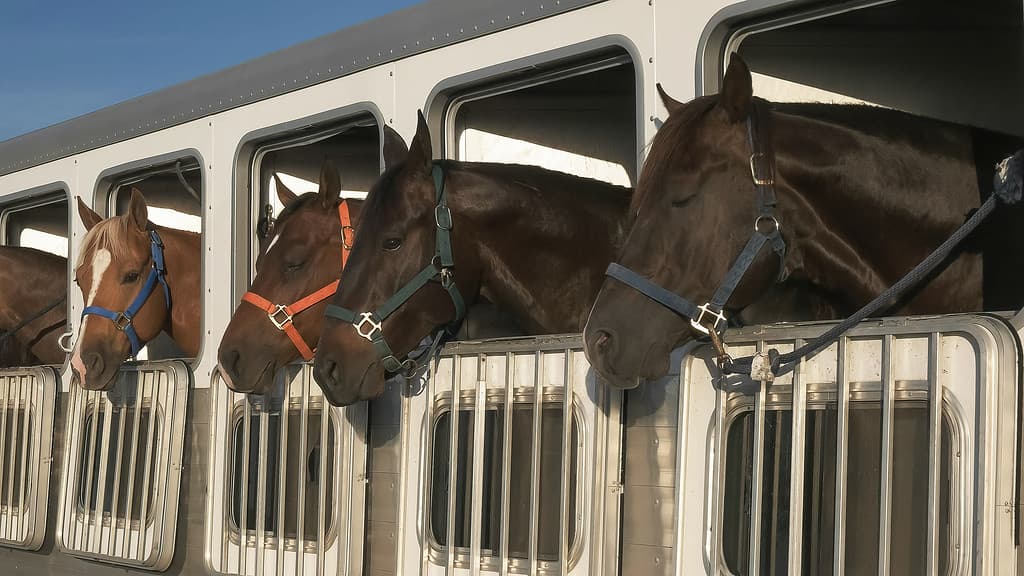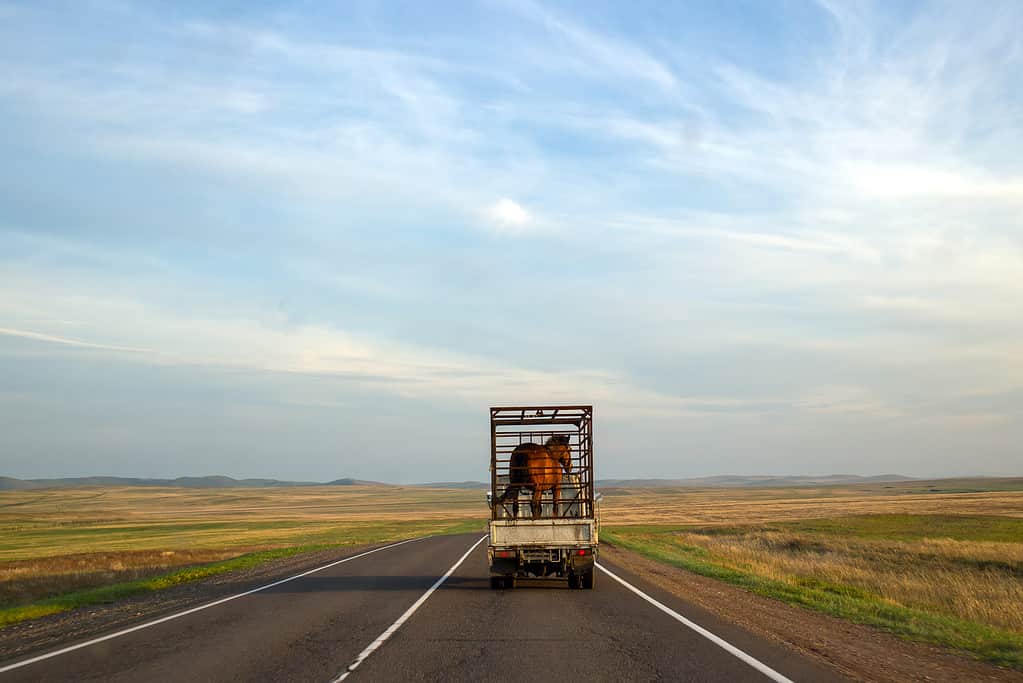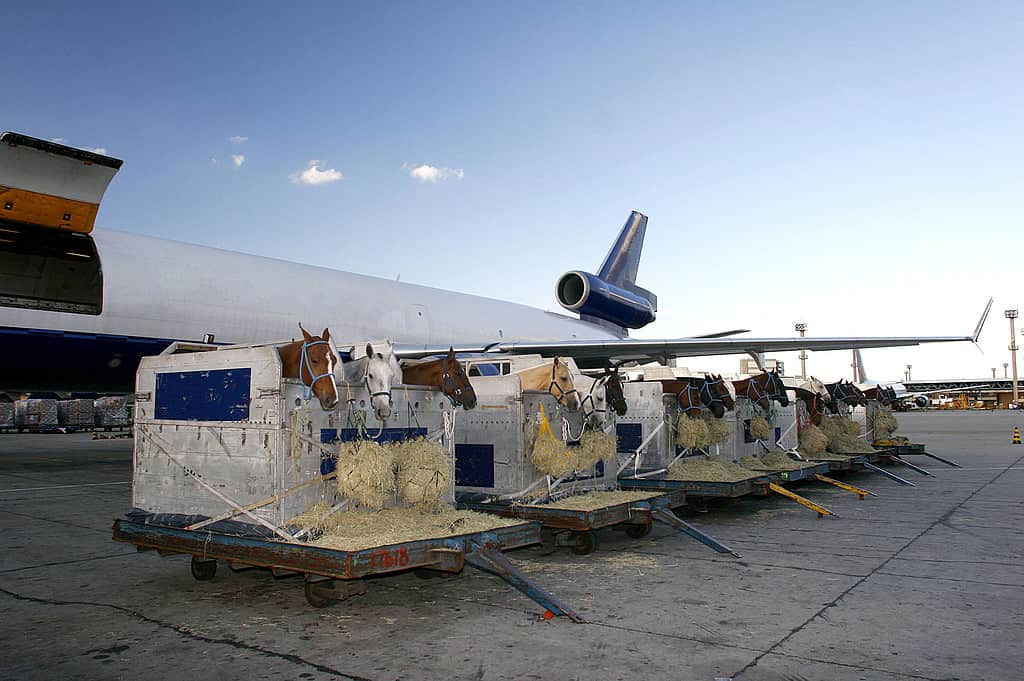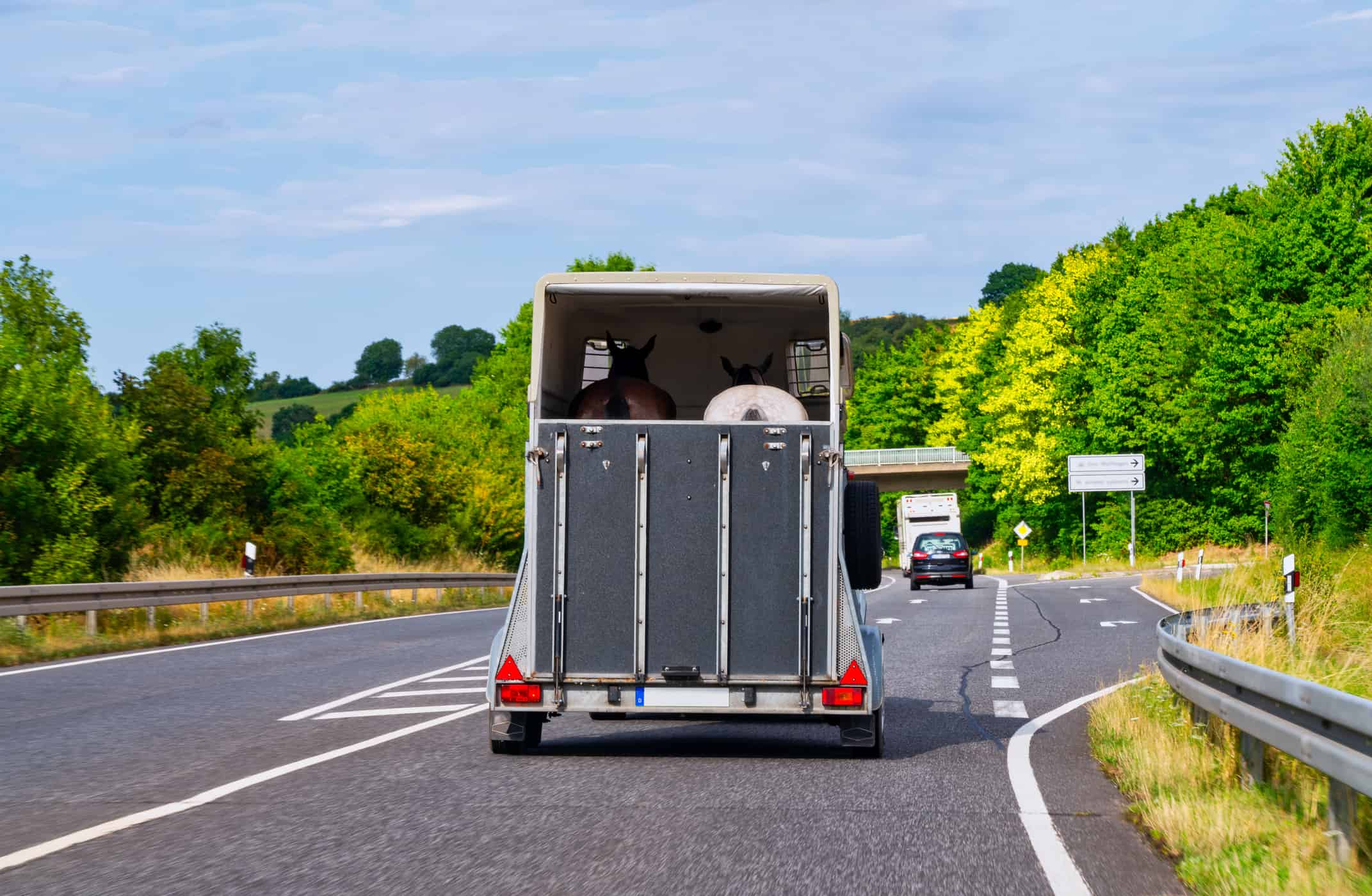Horses have long been used as modes of transportation for humans, but what about when they need transportation of their own? You’ve probably seen a truck hauling a trailer full of horses down the highway. However, you might be surprised to know that’s not the only way to transport a horse. Let’s discuss the top ways horses travel to and from — depending on the distance and your budget — as well as tips to get them to their destination safely.
What Is the Best Way For a Horse to Travel?

Horses can travel alone or in a group, but they like having a buddy for the journey just like we do!
©crbellette/iStock via Getty Images
The best way to transport your horse depends on a few factors, one of them being distance.
If You’re Traveling a Short Distance
If your horse is going to a local show or nearby barn, self-hauling a pull-behind trailer is the perfect way to get them there. There are different types of trailers such as slant loads, straight loads, or box stalls, so the choice is yours when it comes to what works best for your horse.
Just be sure to provide a hay net for them to graze on during the trip and access to water at rest stops every four hours (minimum).
But what do you do if you need to travel across the country or even the ocean? A trailer just won’t do.
If You’re Transporting a Long Distance
Transporting a horse long distances is similar to how humans travel. Depending on our destination, we go by air or sea. So do horses!
It’s common to transport horses on a cargo plane, especially when they’re traveling to the Olympics. You would only ship a horse overseas, but even then, flying is recommended. We’ll talk more about why later!
Meanwhile, let’s discuss the other factor in choosing the best way to transport your horse: budget.
What Is the Average Cost of Transporting a Horse?

There are many different ways to get your horse from A to Z and the cost depends on a variety of factors.
©avtk/iStock via Getty Images
The average cost to transport a horse depends on where you’re going, what you’re bringing, and whether you or hired help is hauling. You also have to consider the price of permits, vaccines, or documentation to get to where you want to go.
The average cost to transport a horse is between $2,000 to over $20,000. It’s less expensive to self-haul your horse to a local show than ship them overseas, but it’s not cheap any way you look at it.
If you decide to hire a commercial horse shipping service to transport your horse, it will save you time but certainly not money. But even if you self-haul to save a buck, you have to think about the cost of:
- The truck and trailer
- Gas to get to and from
- Other supplies like hay nets, buckets, and shavings
And you can only drive cross-country, at most, with a truck and trailer. If you want to travel internationally, you need to choose another way to transport your horse. Let’s go over the different ways you can do that!
5 Ways to Transport a Horse
Horses can go wherever you go (mostly). Here’s how they get there!
1. On a Trailer

Horse trailers are a popular way to transport horses to both local and cross-country shows.
©acceptfoto/iStock via Getty Images
This is the most common way to transport a horse locally and across state lines. It’s also the most economical, especially if you do it yourself. But what if you have a long drive ahead of you… exactly how long can your horse travel in the trailer?
The Kentucky Horse Council recommends you pull over every four hours and stop for at least 20 minutes. Don’t unload though! Park in a shaded area and open the trailer windows to get a breeze going for them in the trailer. Use this time to do a visual check of your vehicle and horse.
If you decide to hire a commercial horse shipping service, they have the same standards — stops every three to hours, visual inspections of the vehicle and horses, routine water buckets and hay bag refills, etc. This convenience will cost you $1 to $2 per mile.
However, hauling a trailer isn’t the quickest way to transport a horse. But it sure is cheaper than flying them!
2. By Plane

Flying your horse internationally is fast but can get pricey.
©Leila Melhado/iStock via Getty Images
International trips for humans require a plane ride and horses are no different. Their tickets are just a tad more expensive. Oh, and they require a chaperone — either you or someone you hire to travel with them.
If you fly your horse, even without all of the add-on luxuries available, you can expect to pay between $4,000 and over $20,000. That’s because the logistics are complex and horses are large animals, which means certain precautions need to be taken to get them to their destination safely.
For example, horses traveling long distances by cargo plane need to be unloaded after about nine hours. The stress of the journey can cause dehydration and they need at least eight hours of rest to recuperate before transit again.
3. By Rail

Traveling by rail isn’t as common anymore, but you can still transport your horse this way today.
©fastfun23/iStock via Getty Images
While the choice to transport your horse by rail isn’t always available, it’s great to ensure a smooth ride for their journey. This method of transportation is much slower than trailering or flying, but it’s a nice option to have if your horse gets motion sickness.
4. On a Ship

Cargo ships can bring your horse across the ocean, but it’s not the best method of transportation.
©Stephen Schauer/DigitalVision via Getty Images
Transporting your horse by ship is a last resort method. Ships are commonly delayed and take a long time to reach their destination. A horse’s physical and mental health can deteriorate if they’re cooped up for too long, so this option isn’t recommended.
However, oar or sail-powered boats were the only way to transport horses across the ocean over 3,000 years ago. Quite obviously, this method led to seasickness — which often led to colic — and was not easy on the animals. Thankfully, technology and transportation have evolved since then.
The final way to transport a horse is tried, like with ships, but much more true to form. Any guesses?
5. By Hacking or Ponying

Hacking out on a horse is the most fun way to get to your destination!
©Canon_photographer/Shutterstock.com
We can’t forget the number one best way to transport a horse: Ride it! Hacking a horse is the most fun way to get from here to there, even if it’s not the most convenient or accessible at all times. If you rode horses at a lesson barn (as a child or an adult), you might remember going through a drive-thru or two on horseback ponying the younger kids around!
This method of transporting a horse is free… well, except for the cost of the horse itself.
Safety Tips for Transporting a Horse

To keep your horse safe while traveling, make frequent stops, offer them a drink, and protect their legs with wraps.
©peplow/iStock via Getty Images
When it comes to your horse, there is quite a long list of requirements for safely transporting them. Here are a few things to keep in mind:
- Make sure your horse wears protective leg gear while traveling
- Consider acclimating them to short distances before you prepare for a long-haul
- Bring your horse’s health records along with you
- Cover their eyes during travel if they get stressed
- Make regular rest stops every 4 hours for short trips and every 9 hours for long ones
- Allow your horse access to forage during the journey
- Keep them hydrated (add electrolytes to their water, if needed)
Stay safe and happy travels!
Thank you for reading! Have some feedback for us? Contact the AZ Animals editorial team.








